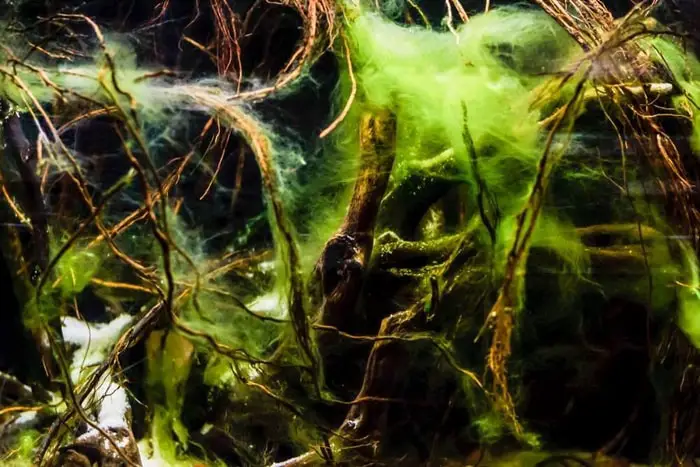Last Updated on January 23, 2022 by Fabiola L.
How to clear fish tank water fast in your aquaponics can be done by first understanding the cause of the cloudy fish tank. This is a potential health risk to the fishes or stunt the growth of your plants. Cloudiness or turbidity of the water comes from particles floating around in your water measured as Total Suspended Solids (TSS). An excessive amount of suspended solids in your water could potentially damage the gills of the fish, cause algal growth, or clog your pipes.
Turbidity in water could be a sign of nutrient imbalance, algal growth, or sediment buildup in your aquaponics system. We will go over common causes of cloudy water in your system and what are the safest and best solutions.
Excessive Buildup Of Sediments Will Cause Cloudy Water In Fish Tank
Causes
Gravel, limestone, clay balls, and other types of rocks are common aquaponics mediums. Hobbyists and backyard growers choose these because they are cheap and easily available. Washing would remove most of the sediments and particulates from the medium. Although leftovers found from the small folds and cracks that will be difficult to remove immediately. Buildup occur from fish feed and excretion if not filtered and removed properly from your mechanical filter. The fish feed and excretion could also build up in your media bed over time without proper mechanical filtration and regular flushing.
How To Clear Cloudy Fish Tank Water Through Sediment Removal
A simple yet effective solution is to use a settling tank or radial filter which makes use of sedimentation and solids removal as discussed by Dr. Wilson Lennard. Particles and sediments from your tank will fall to the bottom and this allows for ease of removal. This is heavily affected by your system’s water flow rate and fish stocking density. I personally run my systems with low fish stocking density and have the volume of my sediment removal system or mechanical filter at 50% to 75% of total fish tank volume with my water flow rate at 50% of the Aquaculture Tank’s volume. I flush out the collected sediments daily to reduce my Chemical Oxygen Demand (COD), and Biological Oxygen Demand (BOD).
As an example, if I have a 1000L fish tank with a fish stocking density at 15 kg/m3, I would design my flow rate to be 500L per hour. Dr. Lennard suggests a retention time of 1 hour for the water. In order to achieve the suggested retention time, my settling tank will need to be 500L in order to allow smaller particles from the water to settle.
If you are running an aquaponics system with high fish stocking, mechanical filters will be needed to control the excessive amount of waste generated. There are numerous mechanical filtration and solids filtration designs that could be used based on the availability of your materials and your budget.
There are different designs of settling tank, media bed, or mechanical filters, it is up to the grower to choose. What’s important is to regularly maintain and flush out sediments from these components.
Read more about How Many Bio Balls Per Gallon Of Water? Your Answers Here!
Increased pH Levels Will Cause Precipitates To Form
Causes
Precipitation in aquaponics is not related to rain. It refers to a chemical reaction in which solids are formed in a solution. Your aquaponics water is filled with different chemical elements from both the aquaculture and hydroponics components. By definition, it is a solution in which precipitation reactions could potentially occur. A common cause of precipitation forming in your water would be high pH values. The solids that would form from this are mostly phosphates and plant micronutrients like Iron (Fe). Calcium carbonate will also form with pH levels of 7.5 and above, which could also come from the use of limestone in your aquaponics system.
Lowering pH Will Lead To Less Cloudy Water In Fish Tank
The most direct solution to remove precipitates from your aquaponics water would be to balance your system’s pH. A healthy pH range for an aquaponics system is anywhere between 6 to 7. As your pH lowers back to 7, solid precipitates will start to dissolve in water again. The dissolved particles will then be chemically available for plants to take up as nutrients.
Iron deficiency is also one of the most common deficiencies in aquaponics. The use of chelated iron is advisable to remedy this deficiency without forming iron precipitates.
Exposure To Sunlight Will Lead To Algal Growth
Causes
As water is exposed to sunlight, it allows for photosynthesis of algae to occur. Aquaponics water being rich in nutrients for plants to grow will also promote the growth of algae. This could cause a number of issues with your aquaponics system. These issues include increased BOD, clogged pipes, and competition for nutrients of your plants. You can commonly find microalgae on the walls of your fish tank, hydroponics units, pipes, or on the surface of your media. Algae is easily distinguishable from the other causes of cloudy water due to the color of the cloudiness.

Learn more about: Bacterial Bloom During Cycle For Aquaponics
How To Clear Fish Tank Water Fast From Algal Growth
Preventing algal growth is as simple as ensuring that no sunlight directly hits your water. Though your aquaponics water is nutrient rich, algae will not grow unless sunlight directly hits the water. To limit the amount of sunlight that touches the water, avoid the use of translucent materials for components that hold water. Most of my aquaponics systems utilize a shallow water culture raft hydroponics component in which I use styrofoam as a top cover for the system. Styrofoam is easy to use, affordable, a good insulator, and could reflect sunlight away from your system.
Conclusion
Suspended particles from the natural processes and inputs reacting with each other in your aquaponics water cause your water to become cloudy. Cloudy water is not necessarily a bad sign for your system as some growers do prefer to have tea-like aquaponics water. Different practices like using worm tea compost for your aquaponics system will also contribute to cloudiness in water. Although these are not detrimental to the fish or to the plants. Turbidity is a visual parameter that is commonly used as a qualitative indicator of your aquaponics system. It is always important to first identify the source of turbidity before deciding the proper action needed to take to maintain and adjust your system.

Candace is an aquaponics expert with over 5 years of experience in the field. She has a degree in environmental science from the University of California, Berkeley and a degree in aquaponics from the University of Florida. She is passionate about sustainable agriculture and has a deep knowledge of aquaculture and hydroponics. She has worked on numerous projects and has been involved in the development of aquaponic systems and fish farms. She also has experience in designing and constructing aquaponic systems. With her expertise, Candace is able to advise clients on the most effective and efficient way to construct and manage their aquaponic system. She is an active member of the aquaponic community, often speaking at conferences and seminars. Candace is dedicated to helping others understand the importance of aquaponics, and she is a strong advocate for sustainable food production.

Leave a Reply
You must be logged in to post a comment.